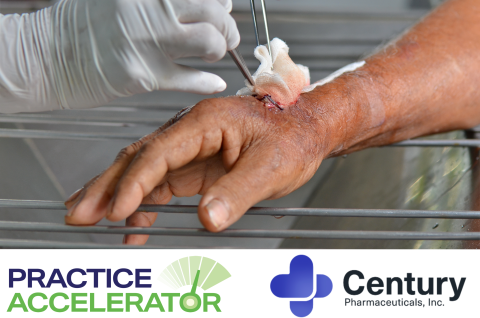How Can Wound Cleansers Aid in Antimicrobial Stewardship?
April 1, 2024
Why Should You Cleanse a Wound?
Wound cleansing may lower infection risk and support healing. It is a component of wound bed preparation, with the capability to remove superficial contaminants, debris, and microorganisms. Proper wound cleansing can also work towards biofilm destruction.1 For example, after a surgical intervention, one cleanses the periwound area to prevent surgical site infection.2 Or, a clinician may employ wound cleansing in a variety of techniques to prepare a wound for, and/or complement, debridement or other treatment strategies. Wound cleansing may also serve as an antimicrobial stewardship strategy when appropriate.
What Options Do Clinicians Have?
Choosing the wound cleanser that is right for a given case is a multilayered process. Topical solutions are selected for use based on wound type and properties, infection type, known effects on biofilm, user-friendliness, availability, and cost effectiveness.3 Depending on the antiseptic, topical application must be prudent to mitigate possible tissue damage.4 There are some cleansing solutions that do not have specific antimicrobial properties, such as sterile normal saline (0.9% sodium chloride) and sterile or potable tap water. These solutions are isotonic or hypotonic and nontoxic.
Solutions containing agents with antimicrobial properties may thwart microorganisms in living tissue in several ways, including potentially interfering with cell signaling and destroying cell membranes.5 Products with antimicrobial properties include4,6,7:
- Halogenated compounds (iodine/iodophor agents such as povidone-iodine, cadexomer iodine)
- Chlorous agents (sodium hypochlorite)
- Hypochlorous acid
- Alcohol-based agents
- Biguanides (polyhexanide or polyhexamethylenebiguanide [PHMB], chlorhexidine)
- Quaternary ammoniums (octenidine, benzalkonium chloride)
- Silver
- Honey
What You Should Know About Some Common Wound Cleansers
Iodine. Cleansers containing iodine in its most-used forms (ie, povidone-iodine and cadexomer iodine) may reduce the wound’s microbial burden.2,5 Povidone-iodine affects the structure and function of bacterial and fungal cells.2,5 In addressing radical oxygen species, povidone-iodine demonstrates anti-inflammatory capabilities.2,5 Cadexomer iodine controls iodine release and absorbs exudates, aiding in wound debridement. These 2 forms of iodine can address a broad spectrum of pathogens while helping remove debris and microbial matter from the wound, thus decreasing wound size and depth.4 The literature is somewhat split on cautionary aspects of iodine as a wound cleanser, but there are generalized warnings against use in the context of iodine or shellfish allergies, in those undergoing radio-iodine therapy, pregnant or lactating women, and those with thyroid disorders.8
Biguanides. Biguanides act on bacterial cell walls, compromising their permeability and causing leakage, leading to bacterial death.9
Chlorhexidine. The cationic biguanide chlorhexidine is commonly used to cleanse and disinfect the periwound area. A broad-spectrum antimicrobial, chlorhexidine often is used for preoperative, prophylactic cleansing of the intended surgical site. It has been found to be nonirritating and nontoxic, with few irritant reactions.4
Polyhexamethylene biguanide. PHMB may be used to control Gram-positive and Gram-negative bacteria, including methicillin-resistant Staphylococcus aureus and vancomycin-resistant Enterococci.9 It also is effective against fungi, including species of Candida and Aspergillus; amoeboids (eg, Acanthamoeba species), and certain viruses. PHMB causes few negative side effects and, similar to iodine, is incorporated into many different types of dressings.4,9
Sodium Hypochlorite. Sodium hypochlorite has action against a variety of microorganisms, including aerobes, anaerobes, fungi, and viruses.10 It has also shown effectiveness against certain resistant bacteria. Dilute solutions are available for use as wound cleansers. One in-vitro study specifically found a 0.05% solution effective in reducing MMP-9 activity.11 The most common side effects include redness, swelling, skin irritation, and allergic reactions.12 Adverse effects are more likely at higher concentrations of solution. Compared with normal saline, one study found cleansing with 0.1% sodium hypochlorite solution to be more effective when managing infected DFUs.13
Conclusion
Wound cleansers have been found valuable to address wound infection proactively, with fewer negative consequences than systemic antibiotic use. They are also an important step in wound bed preparation. One should still choose these cleansers thoughtfully, as with any antimicrobial agent. Although considerations such as cytotoxicity, absorption, allergies and others should factor into choosing the best wound cleanser for each patient, the outcomes underscore the viability of topical wound cleansing protocols.
References
- Oropallo A, Rao AS, Pin CD, Rainier-Maguire M, Mathew A. An objective comparative study of non-surgical cleansing techniques and cleanser types in bacterial burden management. Int Wound J. 2024;21(2): https://doi.org/10.1111/iwj.14730
- Chen S, Chen JW, Guo B, Xu CC. Preoperative antisepsis with chlorhexidine versus povidone-iodine for the prevention of surgical site infection: a systematic review and meta-analysis. World J Surg. 2020;44(5):1412–1424. doi: 10.1007/s00268-020-05384-7
- Tran K, Spry C. Antimicrobial or Antiseptic Cleansers for Wounds. Ottawa, ON: Canadian Agency for Drugs and Technology in Health. 2023.
- Yousefian F, Hesari R, Jensen T, et al. Antimicrobial dressings: a concise review for clinicians. Antibiotics (Basel). 2023;12(9):1434. doi: 10.3390/antibiotics12091434
- Baretto R, Barrois B, Lambert J, Malhotra-Kumar S, Santos-Fernandes V, Monstrey S. Addressing the challenges in antisepsis: focus on povidone iodine. Int J Antimicrob Agents. 2020;56(3):106064. doi: 10.1016/j.ijantimicag.2020.106064
- Barrigah-Benissan K, Ory J, Sotto A, Salipante F, Lavigne JP, Loubet P. Antiseptic agents for chronic wounds: a systematic review. Antibiotics (Basel). 2022;11(3):350. doi: 10.3390/antibiotics11030350
- Kędziorą A, Wieczorek R, Speruda M, et al. Comparison of antibacterial modę of action of silver ions and silver nanoformulations with different physico-chemical properties: experimental and computational studies. Front microbiol. 2021;12:10.3389/fmicb.2021.659614
- Bigliardi PL, Alsagoff SAL, El-Kafrawi HY, et al. Povidone iodine in wound healing: a review of current concepts and practices. Int Surg J. 2017;44:260-268. https://www.sciencedirect.com/science/article/pii/S1743919117305368
- Rippon M, Rogers AA, Westgate S, Ousey K. Effectiveness of a polyhexamethylene biguanide-containing wound cleansing solution using experimental biofilm models. J Wound Care. 2023;32(6):https://doi.org/10.12968/jowc.2023.32.6.359
- Maniscalco R, Mangano G, Joannon AC, et al. Effect of Sodium Hypochlorite 0.05% on MMP-9 Extracellular Release in Chronic Wounds. J Clin Med. 2023;12(9): 3189. https://doi.org/10.3390/jcm12093189
- Barbour ME, Maddocks SE, Grady HJ, et al. Chlorhexidine hexametaphosphate as a wound care material coating: antimicrobial efficacy, toxicity and effect on healing. Nanomedicine. 2016;11(16):https://doi.org/10.2217/nnm-2016-0084
- Keyes M, Jamal Z, Thibodeau R. Dakin Solution. In: StatPearls [Internet]. StatPearls Publishing; 2024: https://www.ncbi.nlm.nih.gov/books/NBK507916/
- Jaber D, Younes N, Khalil E, Albsoul-Younes A, Mismar A, Nassar M, Al-Bakri AG. Effect of Diluted Dakin's Solution Versus Standard Care on Diabetic Foot Ulcer Management: A Randomized Controlled Trial. J Am Podiatr Med Assoc. 2022;112(1):200-213. doi: 10.7547/20-213. PMID: 34233350.
Further Reading
- Wang P, Wang D, Zhang L. Effectiveness of chlorhexidine versus povidone-iodine for preventing surgical site wound infection: a meta-analysis. Int Wound J. 2023. https://doi.org/10.1111/iwj.14394
- Soeselo DA, Yolanda R, Zita M, Theresia S, Astiarani Y, Santi BT. Antiseptic versus non-antiseptic solutions for preventing infection in acute traumatic wounds: a systematic review. Wound Care. 2022;31(2):162–169. doi: 10.12968/jowc.2022.31.2.162
- Berrios-Torres S, Umscheid CA, Bratzler DW, et al. Centers for Disease Control and Prevention Guideline for the Prevention of Surgical Site Infection, 2017. JAMA Surg. 2017;152(8):784–791. doi: 10.1001/jamasurg.2017.0904
The views and opinions expressed in this blog are solely those of the author, and do not represent the views of WoundSource, HMP Global, its affiliates, or subsidiary companies.












Follow WoundSource
Tweets by WoundSource